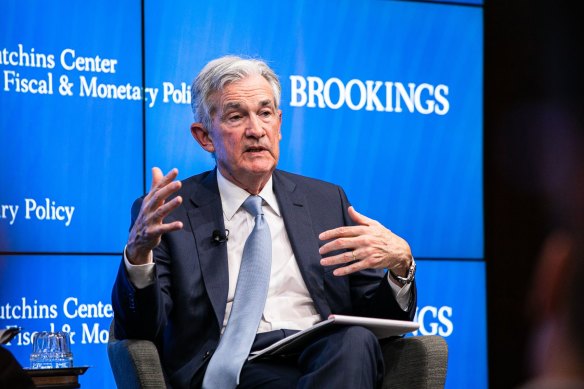How Jerome Powell shook the markets by saying nothing new about interest rates
From their reaction to a speech by US Federal Reserve Board chairman, Jerome Powell, financial markets clearly came to the conclusion that no new news is good news.
The US sharemarket was up three per cent, the Nasdaq tech-oriented market 4.4 per cent and an index of the mega-techs like Amazon, Google and Meta (Facebook’s parent) leapt 7.3 per cent after Powell delivered his speech to the Brookings Institute on Wednesday in the US.

In the US bond market, prices rose and yields fell (they have an inverse relationship). The yield on 10-year US government bonds was down 44 basis points to 3.61 per cent and on two-year notes 17 basis points to 4.3 per cent.
It wasn’t that Powell said anything surprisingly positive in his address but rather that his comments were perfectly in tune with the conclusions market participants drew from the minutes of the Fed’s Open Market Committee (FOMC) October meeting that were released last week.
Essentially, those were that the Fed will imminently reduce the size of future rate rises from the “jumbo” 75 basis point hikes of its past four meetings and slow the pace of future rate rises.
“The time for moderating the pace of rate increases may come as soon as the December meeting,” Powell said on Wednesday adding, in response to questions, that he and his colleagues didn’t want to “overtighten.”
That’s an obvious signal that Powell expects that, at the next FOMC meeting in the middle of this month, the size of the rate increase will be pared back to 50 basis points.
That would see the Fed ending the year with a range for its federal funds rate (the US equivalent of our cash rate) of between 4.25 per cent and 4.5 per cent and would mean that, since the cycle began in March, the Fed would have lifted US rates by 4.25 per cent this year.
Powell repeated the message from the October minutes that, while the size of future rate increases might be smaller and the pace slower, the ultimate level of rates – what the markets refer to as the terminal rate – might be higher and remain at its peak level for longer than previously anticipated to bring US inflation down towards the Fed’s target rate of two per cent.
There have been signs that the US inflation has peaked, as is also the case in Australia and, perhaps surprisingly given the war in Ukraine and the dramatic rise in energy costs, even in the eurozone.
In October the US rate fell from an annualised 8.2 per cent to an admittedly still unsustainable 7.7 per cent and core inflation (which excludes volatile energy and food prices) also seems to be edging down. In Australia the headline inflation rate was down from 7.3 per cent to 6.9 per cent. In the eurozone, data released on Wednesday showed a better-than-expected drop from 10.6 per cent to 10 per cent.
The slump in oil prices and the receding of the pandemic’s effects is showing up in the inflation data and household budgets.
US fuel prices were above $US5 a gallon earlier this year. They are now about $US3.50 a gallon. A return to near-normality in pandemic-disrupted global supply chains is helping, as is a softening of consumer demand after the pandemic era spending binge. Corporate profit margins are shrinking and profit growth is slowing.
The US jobs market, where unemployment is at 3.7 per cent and near half-century lows, does appear to be weakening in an economy where third-quarter growth was better than expected but the year will end on a weaker note than it began.
Thus, in the US and elsewhere, the early indicators that the rapid rises in policy rates and the withdrawal of the massive infusions of liquidity and fiscal stimulus central banks and their governments pumped into their economies in response the pandemic are starting to have an impact on still-unpalatable inflation rates.
The apparent consensus within the Fed about the near term outlook for inflation and rates displayed in the minutes of the October meeting might not last because US monetary policy (and, for that matter, Australian monetary policy) is now shifting from a straightforward objective – bringing raging inflation rates under control to a more complex one.
Monetary policy operates with long lags of uncertain duration. The Reserve Bank moved to smaller rate rises earlier than the Fed because it wanted to avoid over-kill; it wanted time to understand the impact of the rate increases it has already made and those that might yet flow (there’s a bank board meeting next week) to impact activity before pushing them to a level that would force the economy into a deep recession.
There are those within the Fed who, from their recent public statements, don’t believe the Fed is close to the level that would do enough, even with another 50 basis point hike in the middle of this month, to get inflation under control.
The US futures markets see the federal funds rate topping out at 5 per cent next year – so one more 50 basis point rise, or two 25 basis point increases beyond what’s expected this month – and then falling sharply in the second half of next year. The “hawks” within the Fed see rates climbing above five per cent and remaining at those levels for longer.

Powell himself posed the key question but didn’t really answer it.
He said that, while the time for moderating the rate rises (from 75 basis point increments to 50 basis points or less) might come as soon as this month’s meeting, the timing of the moderation was far less significant than the question of how much further the Fed would need to raise rates to control inflation and the length of time necessary to hold policy at a restrictive level.
“It is likely that restoring price stability will require holding policy at a restrictive level for some time. History cautions strongly against prematurely loosening policy. We will stay the course until the job is done.”
Monetary policies globally have moved into a grey zone, or that uncertain territory where the policymakers are unsure how much more they need to do to before inflation rates retreat to more palatable levels. Too little would entrench unsustainable highly inflation but they are aware that if they do too much they will cause avoidable economic damage.
There’s a big difference between a soft landing and a mild recession, which is still possible in the US and here, and a deep jobs and futures-destroying one but the lengthy lags between rate decisions and their effects mean that it is challenging to finesse the outcomes.
The lives of central bankers were never meant to be easy but the pandemic and the war in Ukraine have added layers of complexity to decision-making that was already complex as the bankers try to extricate their economies from more than a decade of cheap and easy money policy settings.
The Market Recap newsletter is a wrap of the day’s trading. Get it each weekday afternoon.
Most Viewed in Business
Source: Thanks smh.com